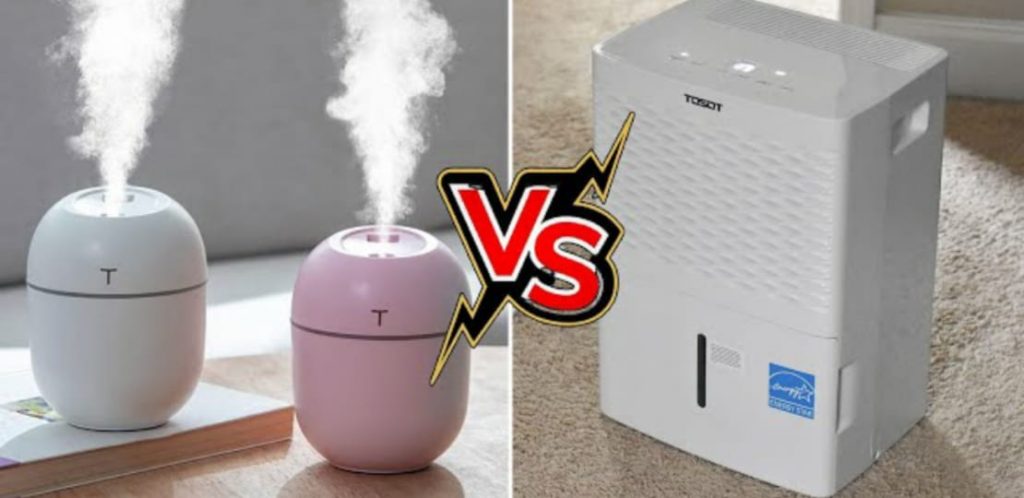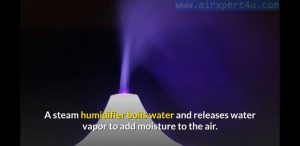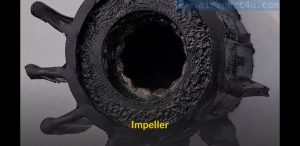
What is the humidifier?
Humidifier and its types: Humidifier vs Dehumidifier. A humidifier is a device that increases the moisture in its immediate environment. When you notice the air outside feels different from the insider air, its likely because of the difference in humidity levels.
You also notice it when it effects your comfort, and that happens when the humidity is too high or too low. The answer to what a humidifier does is at the core of what you will learn from this article.
When you are outside in the rain or in a hot bath with steam up in the air, you are in high humidity. If you are outside during the winter months where the air is devoid of moisture, you are experiencing low air humidity.
How do humidity level affects us?
Humidity is the term that refers to the amount of moisture in the air. For us humans to be comfortable, we require a certain level of humidity. Too high o too low and it becomes unfavorable. The humidity levels have a lot to do with the temperature of the air. Warmer airs hold more moisture and vice versa. Let’s make it more relatable. During summer we feel the heat and sweat it out. The reason that sweat stays longer on our skin is that the warm air is already holding moisture (high humidity). This reduces the chances of your sweat evaporating and makes you even hotter.
On the other hand, during colder days, the air is dry and holds little moisture (low humidity). This causes the moisture on our skin to evaporate faster and cause us to feel cold and experience dry skin. To find comfort we try to balance out the humidity in our favor.
When it is sunny outside, you dash indoors where there is an air conditioner. If it has been ON for a while, you instantly feel the relief. What happened is that you just moved from a location with high humidity to one with low humidity. The air indoor is cooler and the sweat on your body will evaporate in minutes.
Why do you need air humidifiers?
Comfort is the fundamental reason for using a humidifier. It regulates the humidity levels in the indoor air (add moisture) to a point you find comfortable. If the humidity is too high, you could get heat strokes, dehydrations, and other symptoms of hyperthermia.
If it is too low, the dry air can be bad for nasal passages, even cause dry skin, and can make you sick more often. Beyond how it affects you, if the air is too dry for too long, it can affect other things in your home. The expensive wooden floors and furniture can warp and wall paint crack.
So, if you have been wondering if you need a humidifier in your home, there you go!. Weight your options and identify which one will work best for you.
What does a humidifier do?
Humidifiers have only one goal: to add moisture to the air. However, there are different technologies they adopt to regulate indoor humidity. There is a tank that holds cold water in them. The water goes through the different processes depending on the type of humidifier it is. Afterwards, the water flows out of the humidifier into your home in the form of cool air or warm mist to to improve the air quality.
Types of Humidifiers
There are other manual ways you can increase the humidity in your home as placing wet towels in front of your heater duct. Humidifiers are more efficient as they serve their purpose mostly automatically.
There are different types of humidifiers based on the method they adopt to regulate indoor humidity. Some of them also have designs that let you set the humidity level you want. The ideal setting for comfort is somewhere between 45 to 50 percent.
Evaporative
This type is more traditional and uses a cloth, paper, or wick to pull water from the reservoir. A fan blows over it pushing moisture out into your home. Evaporative humidifiers are self-regulating. This is so because humidity in your home increases the rate at which the humidifier adds moisture to the air decrease to avoid moisture saturation.

Ultrasonic Humidifier
This type uses a metal disc that vibrates at an ultrasonic frequency, as the name implies, to break water into fine vapor. This is then distributed into the dry air. Ultrasonic humidifiers work silently. It can also cause a deposit of fog.

Steam
A steam humidifier boils water and releases water vapor to add moisture to the air. One advantage of this type of humidifier is that the boiling kills water-borne bacteria. So, you can rest assure only clean water is flowing out of this moist humidifier. That way, it can significantly reduce the symptoms of your allergies.

Impeller
In this type, a rotating disk throws distilled water towards a serrated diffuser. The diffuser then breaks down the water into mist and flows it out of the humidifier. In this type, you will often see the mist flows out into the air. There is also a type of humidifier you can connect to your air ducts. That way it can serve your entire home and stay out of sight.
One great thing about these types of humidifiers is that they are quite affordable.

how to choose the best type of humidifier for you?
Each of the above types is best for certain conditions. For instance, the steam type is great for relieving allergies as it can prevent you from inhaling dust mites. However, since it involves hot water, using a humidifier this type might not be a good idea with kids around. Moreover, they consume a lot of energies. The ultrasonic and impeller designs will save a lot on energy costs. However, if the water you put in their reservoir contains bacteria, they will emit it into your home as-is.
This is one way a humidifier can be bad for you, specially if you are allergic. So, if you insist on using a humidifier of these types, make sure it is one of those that filter the water first.
It is safe to leave a humidifier ON all night?
Expert advice suggest that you should at least be aware of your reaction to humidity if you want to leave humidifier ON all night. For instance, if the air is dry and the temperature is low, it might be a good idea to leave it ON so it can add cool mist to the air. That way it will alleviate any ailment associated with low temperatures.
Now you know what a humidifier does and how it can help make your home feel more comfortable.
What is the dehumidifier?
Humidity in the home can cause many problems. Often it can cause rooms feels stuffy and smelly. A dehumidifier is an air conditioner that lowers and maintains the humidity level in the air. This is frequently done for reasons of health or thermal comfort, or to remove musty odors and prevent mildew growth by extracting water from the air. It can be used in a variety of settings, including residential, commercial, and industrial. Commercial structures, such as indoor ice rinks and swimming pools, as well as manufacturing companies and storage warehouses, require large dehumidifiers. By operating cooling coils below the dewpoint and draining away the water that condenses, most air conditioning systems combine dehumidification and cooling.
Humidifier Vs Dehumidifier
Maintaining the right level of humidity in your home can be challenging. Throughout the year depending on how dry or humid the air is, you may need to use a humidifier or dehumidifier for added comfort. As mentioned above a place with high temperature and high relative humidity needs moisture to be pulled out of air. Moist air helps the growth of mold, dust mists and sports which aggravate allergies and asthma. A dehumidifier removes moisture from the air and is suited for this climate.
So let’s just see the differences between the two:
- Humidifiers add moisture to the air when it is too dry. Generally, people use humidifiers in the winters time to combat the dryness of the winter air. A dehumidifier takes moisture out of the air when it is too humid.
- The dehumidifiers are used in spring and summers. The two common reasons people use dehumidifiers is to control the seasonal allergies and eliminate the sticky stable feeling a house can have when humidity is high.
- The humidity in most homes is between 30% and 50%. If your home is above 50% then a dehumidifier is needed. However, if the humidity levels are below 30%, a humidifier is needed.
- To determine the humidity level in your home pick up a hygrometer for less than $20 at a home improvement store.
- Both systems help reduce ailments like chest congestion, allergies, and asthma. For example, a dehumidifier can help treat asthma that is triggered by humid air. Or if you are suffering from the cold that caused nasal passage blockage, or sinus congestion, using humidifier will help that break up.
Also read here